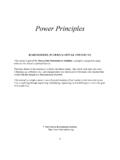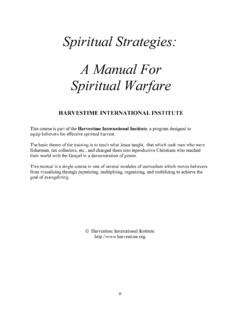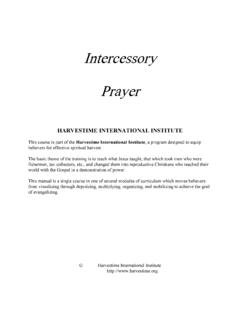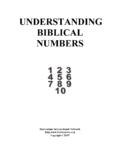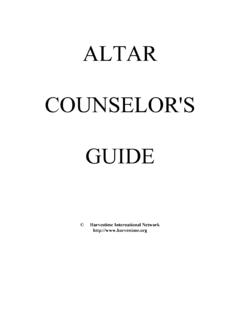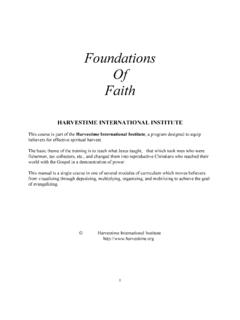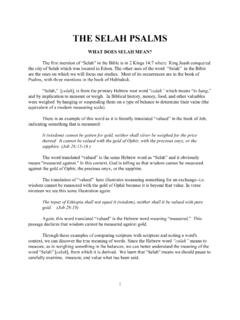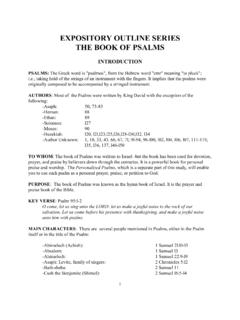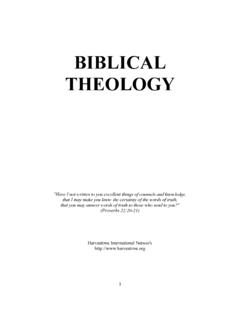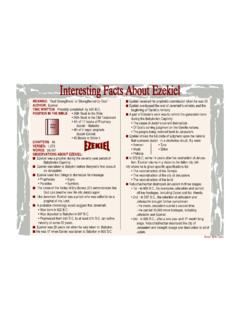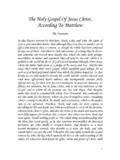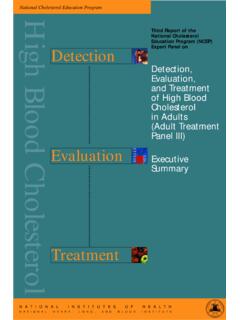Transcription of Basic Bible Survey Part One Old Testament
1 0 Basic Bible Survey part One Old Testament HARVESTIME INTERNATIONAL INSTITUTE This course is part of the Harvestime International Institute, a program designed to equip believers for effective spiritual harvest. The Basic theme of the training is to teach what Jesus taught, that which took men who were fishermen, tax collectors, etc., and changed them into reproductive Christians who reached their world with the Gospel in a demonstration of power. This manual is a single course in one of several modules of curriculum which moves believers from visualizing through deputizing, multiplying, organizing, and mobilizing to achieve the goal of evangelizing. Harvestime International Institute 1 2 TABLE OF CONTENTS How To Use This Manual .. 4 Suggestions For Group Study .. 5 Course Introduction .. 6 Course Objectives .. 7 INTRODUCTION TO THE Bible 1. Introducing The Bible .. 8 2. The Books Of The Bible .
2 20 3. Versions Of The Bible .. 38 4. An Introduction To Outlining .. 44 THE OLD Testament Introduction To The Books Of Law .. 49 5. Genesis .. 50 6. Exodus .. 55 7. Leviticus .. 62 8. Numbers .. 67 9. Deuteronomy .. 72 Introduction To The Books Of History .. 76 10. Joshua .. 77 11. Judges .. 81 12. Ruth .. 87 13. I and II Samuel .. 91 14. I and II Kings .. 96 15. I and II Chronicles .. 102 16. Ezra .. 106 17. Nehemiah .. 110 18. Esther .. 115 3 Introduction To The Books Of Poetry .. 120 19. Job .. 121 20. Psalms .. 126 21. Proverbs .. 132 22. Ecclesiastes .. 136 23. Song of Solomon .. 140 Introduction To The Books Of Prophecy .. 144 24. Isaiah .. 147 25. jeremiah .. 152 26. Lamentations .. 156 27. Ezekiel .. 160 28. Daniel .. 164 29. Hosea .. 170 30. Joel .. 175 31. Amos .. 179 32. Obadiah .. 183 33. Jonah .. 187 34. Micah .. 191 35. Nahum .. 195 36. Habakkuk .. 199 37. Zephaniah .. 203 38. Haggai .. 207 39.
3 Zechariah .. 211 40. Malachi .. 216 Answers To Self-Tests .. 220 4 HOW TO USE THIS MANUAL MANUAL FORMAT Each lesson consists of: Objectives: These are the goals you should achieve by studying the chapter. Read them before starting the lesson. Key Verse: This verse emphasizes the main concept of the chapter. Memorize it. Chapter Content: Study each section. Use your Bible to look up any references not printed in the manual. Self-Test: Take this test after you finish studying the chapter. Try to answer the questions without using your Bible or this manual. When you have concluded the Self-Test, check your answers in the answer section provided at the end of the book. For Further Study: This section will help you continue your study of the Word of God, improve your study skills, and apply what you have learned to your life and ministry. Final Examination: If you are enrolled in this course for credit, you received a final examination along with this course.
4 Upon conclusion of this course, you should complete this examination and return it for grading as instructed. ADDITIONAL MATERIALS NEEDED You will need a King James version of the Bible . 5 SUGGESTIONS FOR GROUP STUDY FIRST MEETING Opening: Open with prayer and introductions. Get acquainted and register the students. Establish Group Procedures: Determine who will lead the meetings, the time, place, and dates for the sessions. Praise And Worship: Invite the presence of the Holy Spirit into your training session. Distribute Manuals To Students: Introduce the manual title, format, and course objectives provided in the first few pages of the manual. Make The First Assignment: Students will read the chapters assigned and take the Self-Tests prior to the next meeting. The number of chapters you cover per meeting will depend on chapter length, content, and the abilities of your group. SECOND AND FOLLOWING MEETINGS Opening: Pray. Welcome and register any new students and give them a manual.
5 Take attendance. Have a time of praise and worship. Review: Present a brief summary of what you studied at the last meeting. Lesson: Discuss each section of the chapter using the HEADINGS IN CAPITAL BOLD FACED LETTERS as a teaching outline. Ask students for questions or comments on what they have studied. Apply the lesson to the lives and ministries of your students. Self-Test: Review the Self-Tests students have completed. (Note: If you do not want the students to have access to the answers to the Self-Tests, you may remove the answer pages from the back of each manual.) For Further Study: You may do these projects on a group or individual basis. Final Examination: If your group is enrolled in this course for credit, you received a final examination with this course. Reproduce a copy for each student and administer the exam upon conclusion of this course. 6 Module: Deputizing Course: Basic Bible Survey I COURSE INTRODUCTION The many references to the Old Testament by Jesus during His earthly ministry illustrate the importance He placed on knowing the content of the Scriptures.
6 Because Jesus stressed the importance of God's Word to the men He trained, Harvestime International Institute presents " Basic Bible Survey " as part of its training program to equip men and women to reach their nations with God's message. " Basic Bible Survey " introduces the Bible and discusses its translations and various versions. It presents an overview of Biblical history, geography, and life in Bible times. The course provides an outline for each book of the Bible and teaches outlining skills for expanding these Basic outlines into more detailed studies of God's Word. Information presented on each Bible book includes the author, the people to whom the book was written, the purpose of the book, the key verse, a list of main characters, and an outline of the content. A life and ministry principle is also stated for each book. These principles are Basic truths vital to Christian maturity and ministry which you should seek to incorporate into your own life. Helpful charts, maps, and time lines summarizing important facts in condensed form are also included in this course.
7 The course is divided into two parts: part One: Provides introductory material on the Bible and outlines for the books of the Old Testament . part Two: Provides outlines for the books of the New Testament . " Basic Bible Survey " is a companion course of "Creative Bible Study Methods" which teaches various ways to study the Bible . Both courses are designed to enrich your personal study of God's Word.* _____ * Since each Harvestime International Institute course is designed to be complete in itself, it was necessary to repeat some introductory material from "Creative Bible Study Methods." Three of the introductory chapters are similar in both courses. 7 COURSE OBJECTIVES Upon completion of this course you will be able to: Identify Basic divisions of the Bible . Explain the difference between versions, translations, and paraphrased editions of the Bible . Describe everyday life in Bible times. Summarize the chronology of the Bible . Create and expand outlines.
8 For each book in the Bible state the following: -Author -To whom the book was written -When it was written -Purpose of the book -Key Verse -Life and Ministry Principle Continue with a more detailed study of God's Word upon completion of this course. 8 part ONE: INTRODUCTION TO THE Bible CHAPTER ONE INTRODUCING THE Bible OBJECTIVES: Upon completion of this chapter you will be able to: Write the Key Verse from memory. Define the word " Bible ." Define the word "Scripture." Explain the origin of the Bible . Identify the major purposes of the Bible . Identify the Old and New Testaments as the two major divisions of the Bible . Name the four divisions of Old Testament books. Name the four divisions of New Testament books. Explain what is meant by the "unity and diversity" of the Bible . Identify the person upon whom the revelation of both testaments center. KEY VERSES: All Scripture is given by inspiration of God, and is profitable for doctrine, for reproof, for correction, for instruction in righteousness: That the man of God may be perfect, thoroughly furnished unto all good works.
9 (II Timothy 3:16-17) INTRODUCTION This chapter introduces the Bible which is the written Word of the one true God. The word " Bible " means "the books." The Bible is one volume which consists of 66 separate books. The word "Scripture" is also used to refer to God's Word. This word comes from a Latin word which means "writing." When the word "Scripture" is used with a capital "S" it means the sacred writings of the one true God. The word " Bible " is not used in the Bible . It is a word selected by men as a title for all of God's Words. 9 ORIGIN OF THE Bible The Bible is the written Word of God. He inspired the words in the Bible and used approximately 40 different men to write down His words. These men wrote over a period of 1500 years. The perfect agreement of these writers is one proof that they were all guided by a single author. That author was God. Some of the writers wrote down exactly what God said: Take thee a roll of a book, and write therein all the words that I have spoken unto thee against Israel.
10 ( jeremiah 36:2) Other writers wrote what they experienced or what God revealed concerning the future: Write the things which thou hast seen, and the things which are, and the things which shall be hereafter. (Revelation 1:19) All of the writers wrote under God's inspiration the words of His message for us. THE PURPOSE OF THE Bible The Bible itself records its main purpose: All Scripture is given by inspiration of God, and is profitable for doctrine, for reproof, for correction, for instruction in righteousness: That the man of God may be perfect thoroughly furnished unto all good works. (II Timothy 3:16-17) The Scriptures are to be used to teach doctrine, to reprove and correct from evil, and to teach righteousness. They will help you live right and equip you to work for God. MAJOR DIVISIONS The Bible is divided into two major sections called the Old Testament and the New Testament . The word " Testament " means covenant. A covenant is an agreement. The Old Testament records God's original covenant or agreement with man.
